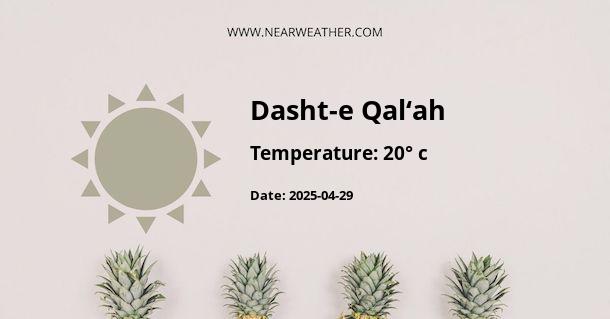Weather
20° 
Climate Conditions: clear sky
Humidity: 48%
Wind speed: 8.32 km/h
Wind direction: 35°
Daily Weather Forecast
Tuesday
04/29/2025
Climate Conditions: clear sky
Humidity: 49%
Wednesday
04/30/2025
Climate Conditions: few clouds
Humidity: 38%
Thursday
05/01/2025
Climate Conditions: clear sky
Humidity: 41%
Friday
05/02/2025
Climate Conditions: scattered clouds
Humidity: 45%
Saturday
05/03/2025
Climate Conditions: broken clouds
Humidity: 49%
Sunday
05/04/2025
Climate Conditions: few clouds
Humidity: 51%
Evolution
Daily Weather Forecast Evolution (°C)
Lowest temperature
Highest temperature
Other Information
Sunrise
05:00
Sunset
18:38
Latitude
37.153900
Longitude
69.443497
Timezone: GMT+05:30
More about Dasht-e Qal‘ah:
Climate and Weather in Dasht-e Qalah, Afghanistan
Dasht-e Qalah is a beautiful region located in Afghanistan. Its climate is classified as arid and semi-arid, with hot summers and cool winters. In this article, we will explore the weather patterns and conditions that prevail in Dasht-e Qalah throughout the year.Temperature
The region experiences a significant variation in temperature throughout the year. Summers in Dasht-e Qalah are scorching hot, with temperatures often exceeding 40 degrees Celsius (104 degrees Fahrenheit). The peak of summer, usually in July and August, can be particularly intense, with temperatures reaching as high as 45 degrees Celsius (113 degrees Fahrenheit). Winters in Dasht-e Qalah are relatively mild, with average temperatures ranging between 5 to 15 degrees Celsius (41 to 59 degrees Fahrenheit). January is the coldest month, with temperatures occasionally dropping below freezing point during the night. However, snowfall is rare in this region.Precipitation
Dasht-e Qalah receives very little rainfall throughout the year, making it a dry and arid region. The average annual precipitation is only around 150 millimeters (6 inches). Most of the rainfall occurs during the winter months, between December and March, with February being the wettest month. Due to the scarcity of rainfall, the region is prone to droughts, and water scarcity can be a significant concern for the local communities. Agriculture and livestock farming heavily rely on irrigation systems to sustain their livelihoods.Wind
Strong winds are a common feature of Dasht-e Qalah's climate. The region is known for its persistent and sometimes fierce winds, which can have a significant impact on the local environment. These winds contribute to the arid conditions by increasing evaporation rates and drying out the soil.Sandstorms
Another phenomenon associated with the arid climate of Dasht-e Qalah is sandstorms. These occur when strong winds lift and carry sand particles, creating a dust cloud that can reduce visibility and potentially cause respiratory problems. Sandstorms are most common during the spring and early summer months.Seasonal Variations
Dasht-e Qalah experiences distinct seasonal variations. Spring, from March to May, brings warmer temperatures and occasional sandstorms. The landscape starts to bloom, with some vegetation able to survive in the arid conditions. Summer, from June to August, is the hottest season in Dasht-e Qalah. The scorching heat can be intense, and the lack of rainfall exacerbates the aridity of the region. It is advisable to plan outdoor activities carefully and stay hydrated during this time. Autumn, from September to November, brings milder temperatures and occasional rainfall. The landscape begins to change colors as some trees and shrubs shed their leaves. It is a pleasant time to explore the region and enjoy outdoor activities. Winter, from December to February, is characterized by cool temperatures and occasional rainfall. While not extremely cold, it is advisable to pack warm clothing, especially for the evenings and nights.Conclusion
Dasht-e Qalah, Afghanistan, experiences an arid and semi-arid climate, with hot summers, cool winters, and very little rainfall. The region's unique weather patterns, including strong winds and occasional sandstorms, contribute to its distinct environment. Understanding the climate of Dasht-e Qalah is essential for planning activities and preparing for the conditions that prevail throughout the year."Dasht-e Qalah's arid climate poses challenges for the local population, particularly in terms of water scarcity and agricultural productivity. It is crucial for the region to develop sustainable water management systems and explore alternative farming practices to overcome these challenges." - Dr. Ahmed Khan, Climate ScientistOverall, Dasht-e Qalah's climate and weather make it a fascinating region to explore, offering a glimpse into the unique challenges and beauty of an arid landscape. Whether you are interested in experiencing the intense heat of summer or the mild winters, Dasht-e Qalah has something to offer for all weather enthusiasts.
FAQ's about Dasht-e Qal‘ah's Weather:
Q - What is the Latitude and Longitude of Dasht-e Qal‘ah?
A - Dasht-e Qal‘ah's Latitude is 37.153900 & Longitude is 69.443497.
Q - What is the weather in Dasht-e Qal‘ah today?
A - Weather in Dasht-e Qal‘ah is 20° today.
Q - What is the climatic condition of Dasht-e Qal‘ah today?
A - Climate Conditions in Dasht-e Qal‘ah shows clear sky today.
Q - What is the humidity in Dasht-e Qal‘ah today?
A - Humidity in Dasht-e Qal‘ah is 48% today.
Q - What is the wind speed in Dasht-e Qal‘ah today?
A - Wind speed in Dasht-e Qal‘ah is 8.32 km/h, flowing at 35° wind direction. today.

Nearby Locations
Latest searched locations